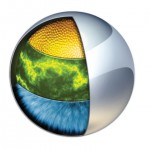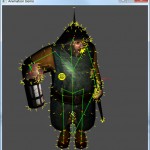This is the second lesson in a series of lessons to teach you how to create a DirectX 12 powered application from scratch. In this lesson, vertex and index data is uploaded to the Graphics Processing Unit (GPU) for rendering. Basic vertex and pixel shaders are described and how to create a Pipeline State Object (PSO) that utilizes those shaders is also described. A root signature defines the parameters that are used by the stages of the rendering pipeline. In this lesson a simple root signature is created that defines a single constant buffer that contains the Model-View-Projection (MVP) matrix that is used to rotate a model in the scene.
Tag Archives: C++
Learning DirectX 12 – Lesson 1 – Initialize DirectX 12
This is the first lesson in a series of lessons to teach you how to create a DirectX 12 application from scratch. In this lesson, you will learn how to query for DirectX 12 capable display adapters that are available, create a DirectX 12 device, create a swap-chain, and you will also learn how to present the swap chain back buffer to the screen. In this lesson, you will also create a command queue and a command list and learn how to synchronize the CPU and GPU operations in order to correctly implement N-buffered rendering.
Forward vs Deferred vs Forward+ Rendering with DirectX 11
In this article, I will analyze and compare three rendering algorithms:
- Forward Rendering
- Deferred Shading
- Forward+ (Tiled Forward Rendering)
Introduction to Shader Programming with Cg 3.1
In this article I will introduce the reader to shader programming using the Cg shader programming language. I will use OpenGL graphics API to communicate with the Cg shaders. This article does not explain how use OpenGL. If you require an introduction to OpenGL, you can follow my previous article titled Introduction to OpenGL.
Introduction to OpenCL
In this article I will provide a brief introduction to OpenCL. OpenCL is a open standard for general purpose parallel programming across CPUs, GPUs, and other programmable parallel devices. I assume that the reader is familiar with the C/C++ programming languages. I will use Microsoft Visual Studio 2008 to show how you can setup a project that is compiled with the OpenCL API.
OpenGL Interoperability with CUDA
In this article I will discuss how you can use OpenGL textures and buffers in a CUDA kernel. I will demonstrate a simple post-process effect that can be applied to off-screen textures and then rendered to the screen using a full-screen quad. I will assume the reader has some basic knowledge of C/C++ programming, OpenGL, and CUDA. If you lack OpenGL knowledge, you can refer to my previous article titled Introduction to OpenGL or if you have never done anything with CUDA, you can follow my previous article titled Introduction to CUDA.
Introduction to CUDA using Visual Studio 2008
In this article, I will give a brief introduction to using NVIDIA’s CUDA programming API to perform General Purpose Graphics Processing Unit Programming (or just GPGPU Programming). I will also show how to setup a project in Visual Studio that uses the CUDA runtime API to create a simple CUDA program.
Continue reading
GPU Skinning of MD5 Models in OpenGL and Cg
This tutorial builds upon the previous article titled [Loading and Animating MD5 Models with OpenGL]. It is highly recommended that you read the previous article before following this one. In this tutorial, I will extend the MD5 model rendering to provide support for GPU skinning. I will also provide an example shader that will perform the vertex skinning in the vertex shader and do per-fragment lighting on the model using a single point light. For a complete discussion on lighting in CgFX, you can refer to my previous article titled [Transformation and Lighting in Cg].
Continue reading
Loading and Animating MD5 Models with OpenGL
In this article, I will show how you can load and animate models loaded from the MD5 model file format. In this article I will use OpenGL to render the models. I will not show how to setup an OpenGL application in this article. If you need to get a quick introduction on setting up an OpenGVL application, you can follow the “Beginning OpenGL for Game Programmers” article [here].
Introduction to DirectX 9 for Game Programmers

DirectX
In this article I will give a quick introduction to DirectX. I will use Visual Studio 2008 as a development environment for this tutorial and I will start by showing how to install DirectX and configure Visual Studio 2008 to start developing DirectX applications. I assume that the reader has basic programming knowledge in C++. If you require a math refresher, you can refer to my “3D Math Primer” articles on Coordinate Spaces, Vector Operations, and Matrices.








